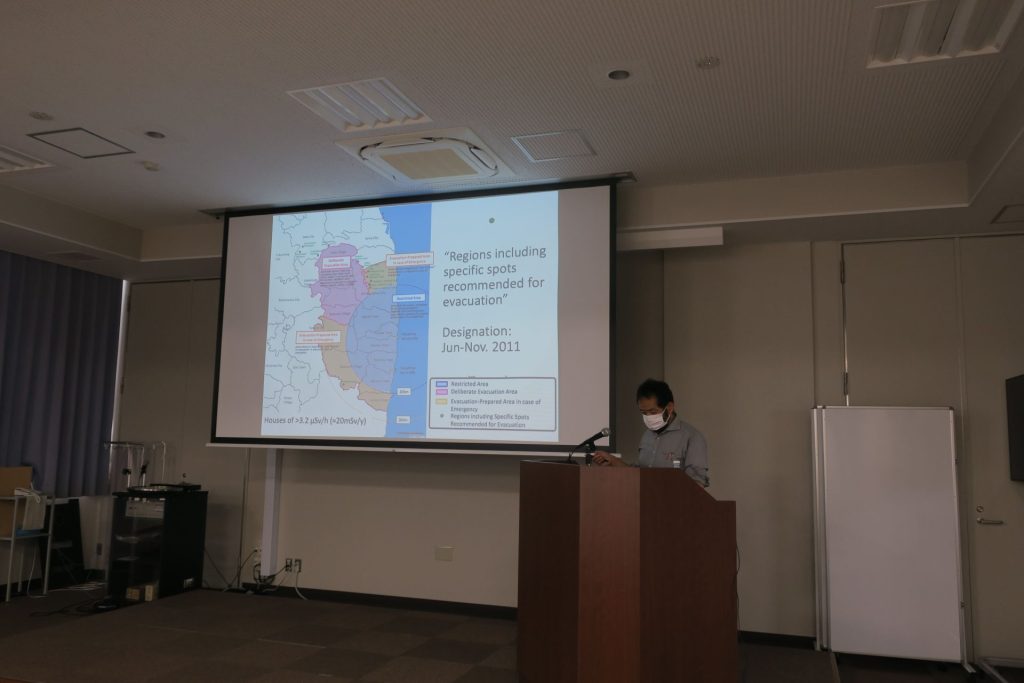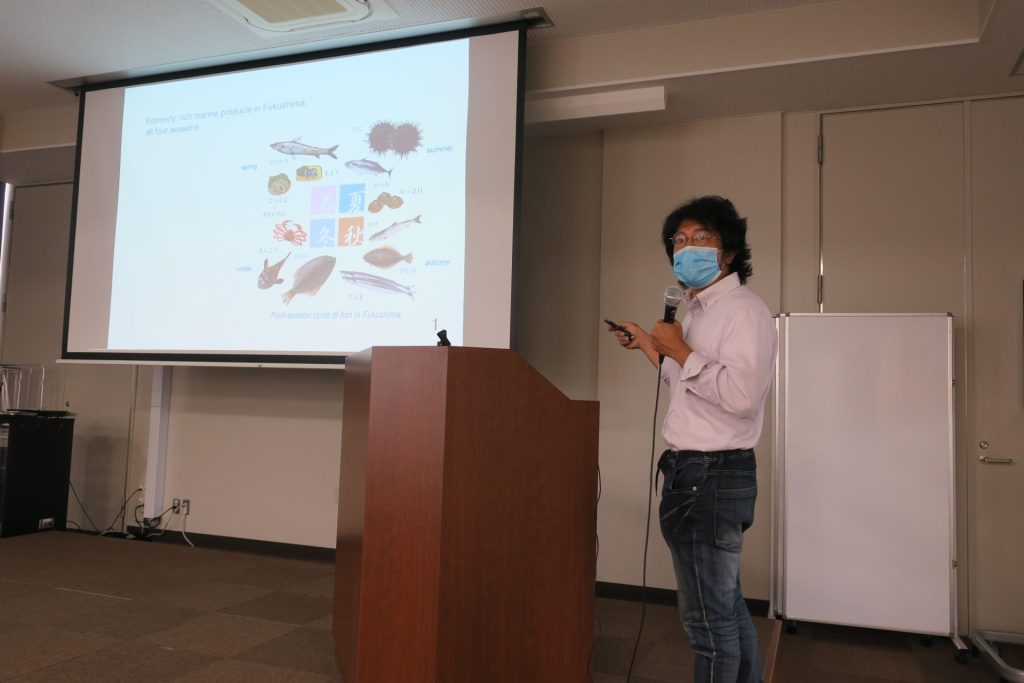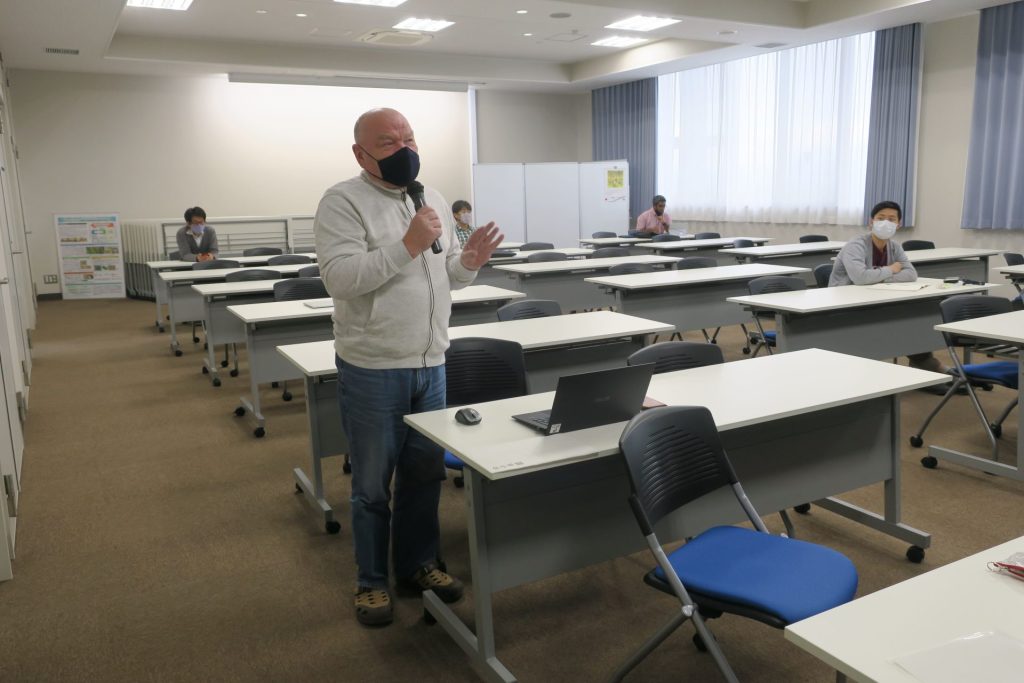September 27, 2021, we held the 4th IER Seminar of FY2021<by Prof. NANBA and Associate Prof. HAYASHI>
Date & Time
Mon. September 27, 2021, 2:00 pm – 3:45 pm
Speakers
Professor NANBA Kenji, Director of the IER
Associate Professor HAYASHI Kumpei (Faculty of Food and Agricultural Sciences)
Titles
Lifting of Evacuation Order (Nanba)
A Regulatory Scientific Approach to the Post-disaster Recovery Issues of Fukushima’s Marine Fisheries (Hayashi)
Institute of Environmental Radioactivity (IER) regularly holds the IER seminar in which the faculty members report on their research results, with the purpose of facilitating their research activities and communication.
At the fourth IER Seminar for this fiscal year held on September 27, Prof. Nanba Kenji, Director of Institute for Environmental Radioactivity, and Associate Prof. Hayashi Kumpei of the Faculty of Food and Agricultural Sciences at Fukushima University gave presentations. The seminar was attended by 15 people, including the faculty members, graduate students, and online attendees.
Prof. Nanba explained the transition of the lifting of evacuation orders in the restricted areas in each municipality in Hamadori, Fukushima Prefecture, in the 10 years after the nuclear accident, introducing various data. The lifting of evacuation orders has been carried out in stages in each municipality on the condition that the following requirements are met, 1) it is certain that annual cumulative doses will become 20 mSv or lower, 2) infrastructure and living-related services necessary for daily lives have been almost restored and decontamination work has progressed, and 3) consultations have been held sufficiently among relevant local government and residents. In March 2020, the evacuation order was lifted in all areas except for the Difficult-to-Return Zones (DRZ). Some areas in the DRZ in Namie Town, Futaba Town, Okuma Town, Tomioka Town, Iitate Village, Katsurao Village, and Minamisoma City have been designated as the “Specified Reconstruction and Revitalization Base (Base)” since 2017, and decontamination and restoration works have been progressing, with plans to lift the evacuation orders in 2022 and 2023. In the DRZ in Iitate village, experimental efforts are made to recycle the removed soil generated by decontamination work. Prof. Nanba then introduced the Japanese government policy announced at the end of August 2021 that efforts will be made for off-Base areas over the 2020s to lift the evacuation orders so that former residents can return to their hometowns if they wish.
Associate Prof. Hayashi specializes in Agriculture, Forestry, and Resource Economics as well as Fishery Economics, and has been working on the reconstruction of Fukushima Prefecture in various fields. In his presentation, he talked about the regulatory science approach to the recovery of fisheries. Immediately after the nuclear power plant accident, coastal fisheries (including offshore trawling) in Fukushima Prefecture were forced to be suspended due to the detection of highly contaminated samples caused by the release of contaminated water into the ocean. However, subsequent data analysis confirmed that the radiocesium concentration in marine fish decreased rapidly, and that the decrease was more noticeable depending on the fish species and habitats.
Associate Prof. Hayashi has been contributing in the recovery of the fisheries in Fukushima Prefecture through a multifaceted approach: 1) data-based approach, 2) step-by-step approach including “pilot-scale trial fishing and sales”, 3) participatory approach by organizing a multi-stakeholder council (Fukushima Prefectural Fisheries Reconstruction Committee) with the Fukushima Prefectural Federation of Fisheries Cooperative Association at its core, 4) rule governance by clearly defining and applying the council’s own rules for restarting operations, restricting, lifting the limitations for fishing areas and targets, and resumption of fishing without being influenced by the nuclear power plant situation or the social environment. He has also been working on the issues of ocean discharge of ALPS treated water and decommissioning, also using the above approach.
Many questions were raised on the criteria for the accumulated dose for the lifting of the evacuation order, and whether the storage and recycling of decontaminated waste will affect the decontamination plan for the DRZ (regarding Prof. Nanba’s talk) and on differences between Japanese and foreign standards for radiocesium levels in food including marine products, and what risk is posed if fish with relatively high concentration is found in the vicinity of the nuclear power plant (regarding Associate Prof. Hayashi’s talk), and lively discussions took place.



